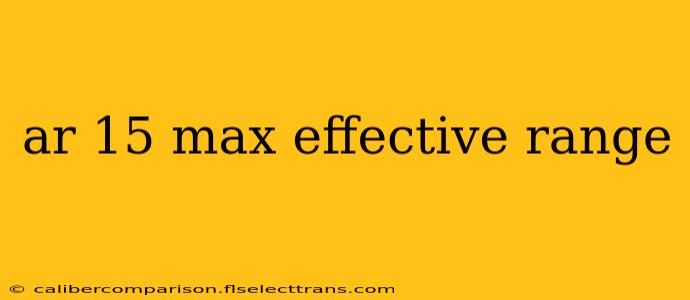The question of the AR-15's maximum effective range is complex and doesn't have a single definitive answer. While the rifle can send a projectile much farther, the effective range depends heavily on several interacting factors, including the ammunition used, the shooter's skill, and the target's size. This article delves into these factors to provide a clearer understanding of what "effective range" truly means in the context of the AR-15 platform.
What is "Effective Range"?
Before we discuss numbers, let's define effective range. It's not simply the distance a bullet can travel before hitting the ground. Effective range refers to the maximum distance at which a shooter can consistently and accurately hit a human-sized target, considering factors like bullet drop, wind drift, and the limitations of the shooter's vision and skill. Beyond this point, the chances of a successful hit decrease significantly.
Factors Affecting AR-15 Effective Range
Several key factors influence the effective range of an AR-15:
1. Ammunition:
- Caliber: The standard 5.56x45mm NATO round is the most common for AR-15s. Heavier bullets generally have better ballistic properties at longer ranges, experiencing less wind drift and retaining more velocity. However, heavier bullets also tend to have lower muzzle velocities.
- Bullet Design: The bullet's shape and construction significantly affect its aerodynamic performance and trajectory. Match-grade ammunition, designed for accuracy, typically performs better at longer ranges than standard military or hunting ammunition.
- Barrel Length: Longer barrels generally yield higher muzzle velocities, leading to flatter trajectories and improved accuracy at longer ranges. However, this comes with increased weight and decreased maneuverability.
2. Shooter Skill:
Even with the best ammunition and rifle, shooter skill is paramount. Factors such as:
- Proper Sight Adjustment: Accurate zeroing at various distances is crucial for consistent hits.
- Breath Control: Managing breathing is key for steady aiming.
- Trigger Control: A smooth, consistent trigger pull prevents flinching and improves accuracy.
- Proper Body Positioning and Stance: A solid stance and proper body positioning significantly enhance accuracy and stability.
All significantly affect the effective range. An experienced marksman can achieve better results at longer distances than a novice, even with the same equipment.
3. Target Size:
Hitting a small target at a long range is significantly harder than hitting a larger one. The effective range will dramatically decrease as the target size decreases. The human-sized target is frequently used as the benchmark.
4. Environmental Conditions:
- Wind: Wind is one of the most significant factors affecting bullet trajectory at longer distances. A strong headwind will cause the bullet to drop more quickly and deviate from its intended path, while a crosswind causes lateral drift.
- Temperature: Temperature variations affect air density, which influences bullet trajectory.
- Humidity: High humidity can also affect bullet trajectory.
So, What is the AR-15 Max Effective Range?
Given the variables mentioned above, pinning down a single number for the maximum effective range of an AR-15 is misleading. However, a generally accepted range is 300-500 yards for a skilled shooter using appropriate match-grade ammunition in a stable environment. Beyond that, hitting a human-sized target consistently becomes extremely difficult. While some shots might hit farther, the probability significantly diminishes, making engagements beyond this range unreliable. For most practical purposes, engagements beyond 500 yards with an AR-15 are highly improbable to result in a successful shot.
Conclusion: Beyond the Numbers
Focusing solely on a numerical range for the AR-15 misses the bigger picture. Effective range is a complex interplay of various factors. Understanding these factors empowers responsible firearm handling and realistic expectations for accuracy at different distances. Always practice safe gun handling and seek professional training to improve your skills.

